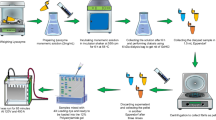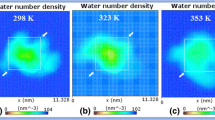Abstract
The urea-induced dissociation of nerve growth factor from venom of Chinese cobra (cNGF) was studied by intrinsic fluorescence emission spectra, SEC, urea-gradient polyacrylamide gel electrophoresis, assays of biological activity and thermodynamic parameters. The results showed that when urea concentration was lower than or equal to 4.0 mol L−1 or higher than or equal to 8.0 mol L−1, cNGF existed only in native homodimer form or monomer form, respectively; whereas when urea concentration was higher than 4.0 mol L−1 and lower than 8.0 mol L−1, they existed simultaneously in the native homodimer and monomer forms and the former decreased, while the latter increased with the increase in urea concentration. Based on the association–dissociation equilibrium between cNGF and urea molecules, an equation, which includes two characteristic dissociation parameters K and ∆m, was presented to describe the urea-induced dissociation process of cNGF. As the reaction temperature increased from 15 to 35 °C, positive enthalpy and entropy changes were observed, and the parameter K increased from 2.72 × 10−13 to 5.18 × 10−12 (L mol−1), while the parameters ∆m and ∆G, respectively, decreased from 10.18 to 8.42 and from −10.27 to −18.67 (kJ mol−1), which means that the urea-induced dissociation of cNGF was spontaneous and entropy-driven and the higher temperature was favorable for the dissociation process. Using the procedures and equations mentioned in the paper, the urea-induced dissociation of cNGF is first comprehensively described. Furthermore, this work presents a useful method for people to study the dissociation of dimer or multimer proteins induced by denaturants, inducers, pH, etc.







Similar content being viewed by others
References
McCleary RJ, Kini RM (2013) Non-enzymatic proteins from snake venoms: a gold mine of pharmacological tools and drug leads. Toxicon 62:56–74
Barbacid M (1995) Neurotrophic factors and their receptors. Curr Opin Cell Biol 7:148–155
Levi Montalcini R (1987) The growth factor 35 years later. Science 237:1154–1162
Fujita K, Lazarovici P, Guroff G (1989) Regulation of the differentiation of PC12 pheochromocytoma cells. Environ Health Perspect 80:127–142
Lecht S, Arien-Zakay H, Wagenstein Y, Inoue S, Marcinkiewicz C, Lelkes PI, Lazarovici P (2010) Transient signaling of Erk1/2, Akt and PLCγ induced by nerve growth factor in brain capillary endothelial cells. Vasc Pharmacol 53:107–114
Tuszynski MH, Conner J, Bleshh A, Smith D, Merrill DA, Lee Vahlsing H (2002) New strategies in neural repair. Progr Brain Res 138:401–409
Capsoni S, Giannotta S, Cattaneo A (2002) Beta-amyloid plaques in a model for sporadic Alzheimer’s disease based on transgenic anti-nerve growth factor antibodies. Mol Cell Neurosci 21:15–28
Hellweg R, Hartung HD (1990) Endogenous levels of nerve growth factor (NGF) are altered in experimental diabetes mellitus: a possible role for NGF in the pathogenesis of diabetic neuropathy. J Neurosci Res 26:258–267
Levi-Montalcini R, Meyer H, Hamburger V (1954) In vitro experiments on the effects of mouse sarcomas 180 and 37 on the spinal and sympathetic ganglia of the chick embryo. Cancer Res 14:49–57
Kostiza T, Meier J (1996) Nerve growth factor from snake venom: chemical properties, mode of action and biological significance. Toxicon 34:787–806
Siigur J, Arumae U, Neuman T, Siigur E, Saarma M (1987) Monoclonal antibody immunoaffinity chromatography of the nerve growth factor from snake venoms. Comp Biochem Physiol B 87:329–334
Thoenen H, Barde YA (1980) Physiology of nerve growth factor. Physiol Rev 60:1284–1335
Xu T, Wang W, Huang Y, MEng Q, Li D, Lu Q, Xiong Y (1999) A nerve growth factor from the venom of Chinese cobra (Naja naja atra) and its effects on male reproductive system in rats. Comp Biochem Phys C 124:149–156
Wei J, Mo Y, Qiao L, Wei X, Chen H, Xie H, Fu Y, Wang W, Xiong Y, He S (2006) Potent histamine-releasing activity of atrahagin, a novel snake venom metalloproteinase. Int J Biochem Cell B 38:510–520
Zhang Y, Zhong L, Zhou B, Chen J, Li C (2013) Interaction of characteristic structural elements of persimmon tannin with Chinese cobra PLA2. Toxicon 74:34–43
Tong Q, Wang F, Zhou H, Sun H, Song H, Shu Y, Gong Y, Zhang W, Cai T, Yang F, Tang J, Jiang T (2012) Structural and functional insights into lipid-bound nerve growth factors. FASEB J 26:3811–3821
Kaplan DR, Stephens RM (1994) Neurotrophin signal transduction by the trk receptor. J Neurobiol 25:1404–1417
Jiang H, Movsesyan V, Fink DW, Fasler M, Whalin M, Katagiri Y, Monshipouri M, Dickens G, Lekles PI, Guroff G, Lazarovici P (1997) Expression of human p140trk receptors in p140trk-deficient, PC12/endothelial cells results in nerve growth factor-induced signal transduction and DNA synthesis. J Cell Biochem 66:229–244
Katzir I, Shani J, Goshen G, Sela J, Ninary E, Dogonovski AM, Shabashov D, Inoue S, Ikeda K, Hayashi K, Gorinstein S, Deutsch J, Lazarovici P (2003) Characterization of nerve growth factors (NGFs) from snake venoms by use of a novel, quantitative bioassay utilizing pheochromocytoma (PC12) cells overexpressing human trkA receptors. Toxicon 42:481–490
Bian L, Wu P, Yang X (2004) Two-step chromatographic method for separation and purification of nerve growth factor from venom of Chinese Cobra. J Chromatogr B 805:119–125
Acknowledgments
This work was financially supported by National Natural Science Foundation of China (No. 21075097) and Key Program for Science and Technology Innovative Research Team of Shaanxi Province (No. 2013KCT-24).
Author information
Authors and Affiliations
Corresponding author
Rights and permissions
About this article
Cite this article
Bian, L., Ji, X. & Hu, W. Urea-Induced Dissociation of Nerve Growth Factor from Venom of Chinese Cobra by SEC. Chromatographia 77, 793–802 (2014). https://doi.org/10.1007/s10337-014-2661-5
Received:
Revised:
Accepted:
Published:
Issue Date:
DOI: https://doi.org/10.1007/s10337-014-2661-5




